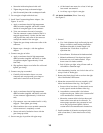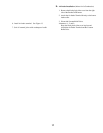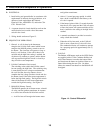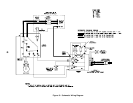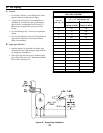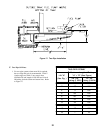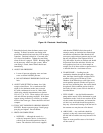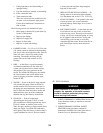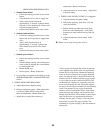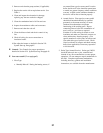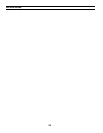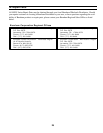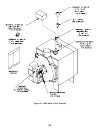
24
i. Fitting leaks due to mis-flared tubing or
damaged fitting.
ii. Fuel line leak due to crushed or bent tubing.
iii. Filter connection leaks.
iv. Tank connection leaks.
There are various test kits available to trace
air leaks, such as electronic sight glasses.
Follow the manufacturers' instructions to
find air leaks.
The following actions can eliminate air leaks:
i. Bleed pump as detailed in System Start-Up
Section of this manual.
ii. Replace flare fittings.
iii. Replace oil supply line.
iv. Repair oil filter leaks.
v. Replace or repair tank fittings.
e. GASKET LEAKS — If 11.5 to 12.5% CO
2
with
a #1 smoke cannot be obtained in the breeching,
look for air leaks around the flue collar. Such air
leaks will cause a lower CO
2
reading in the
breeching. The smaller the firing rate the
greater effect an air leak can have on CO
2
readings.
f. DIRT — A fuel filter is a good investment.
Accidental accumulation of dirt in the fuel
system can clog the nozzle or nozzle strainer
and produce a poor spray pattern from the
nozzle. The smaller the firing rate, the smaller
the slots become in the nozzle and the more
prone to plugging it becomes with the same
amount of dirt.
g. WATER — Water in the fuel in large amounts
will stall the fuel pump. Water in the fuel in
smaller amounts will cause excessive wear on
the pump, but more importantly water doesn’t
burn. It chills the flame and causes smoke and
unburned fuel to pass out of the combustion
chamber and clog the flueways of the boiler.
h. COLD OIL — If the oil temperature
approaching the fuel pump is 40°F or lower
poor combustion or delayed ignition may result.
Cold oil is harder to atomize at the nozzle.
Thus, the spray droplets get larger and the flame
shape gets longer. An outside fuel tank that is
above grade or has fuel lines in a shallow bury is
a good candidate for cold oil. The best solution
is to bury the tank and lines deep enough to
keep the oil above 40°F.
i. HIGH ALTITUDE INSTALLATIONS — Air
settings must be increased at higher altitudes.
Use instruments and set for 11.5 to 12.5% CO
2
.
j. START-UP NOISE — Late ignition is the cause
of start-up noises. If it occurs recheck for
electrode settings, flame shape, air or water in
the fuel lines.
k. SHUT DOWN NOISE — If the flame runs out
of air before it runs out of fuel, an after burn
with noise may occur. That may be the result of
a faulty cut-off valve in the fuel pump, or it may
be air trapped in the nozzle line. It may take
several firing cycles for that air to be fully
vented through the nozzle. Water in the fuel or
poor flame shape can also cause shut down
noises.
G. TEST CONTROLS
WARNING
Before installation of the boiler is considered
complete, the operation of the boiler controls
should be checked, particularly the primary
control and high limit control.
1. CHECK THERMOSTAT OPERATION. Raise and
lower thermostat setting as required to start and
stop burner.
2. VERIFY PRIMARY CONTROL SAFETY
FEATURES using procedures outlined in
Instructions furnished with control (See back of
Control Cover) or Instructions as follows:



